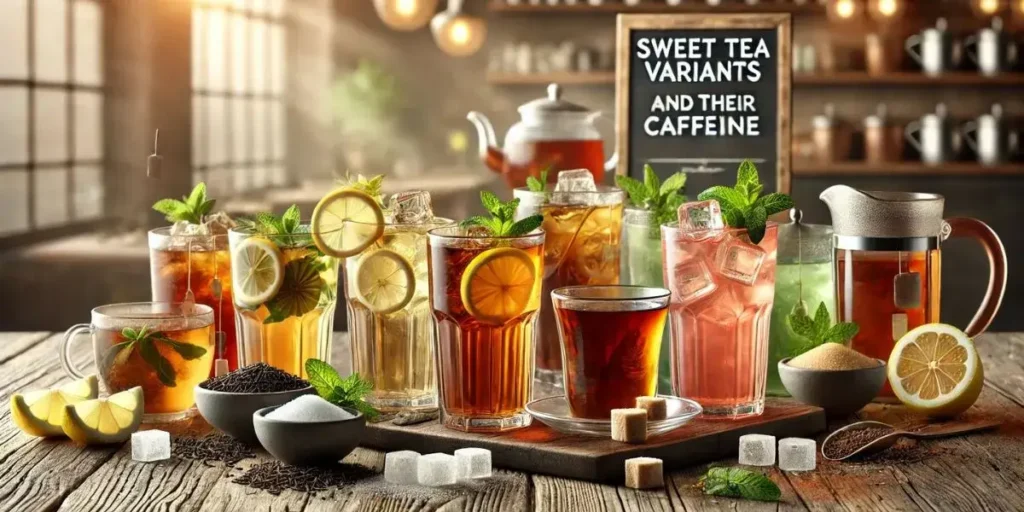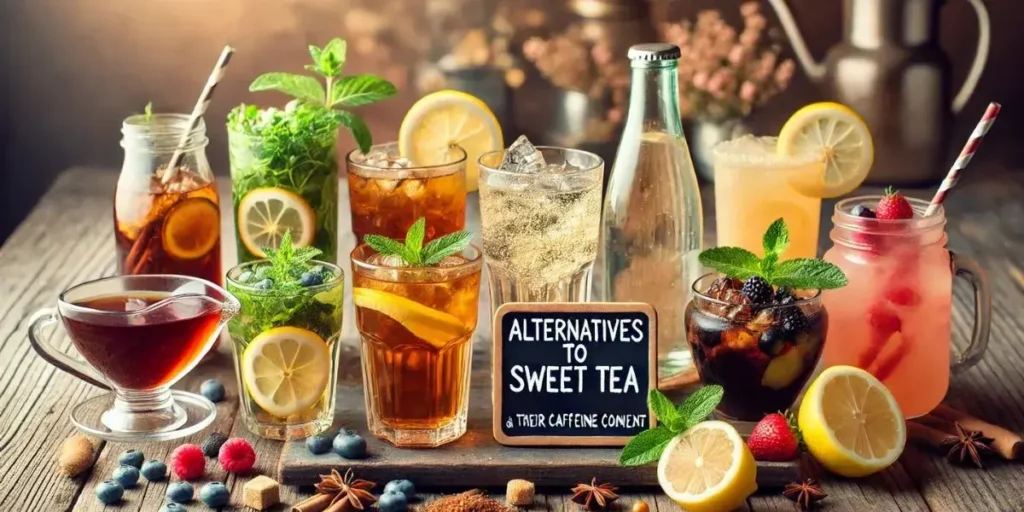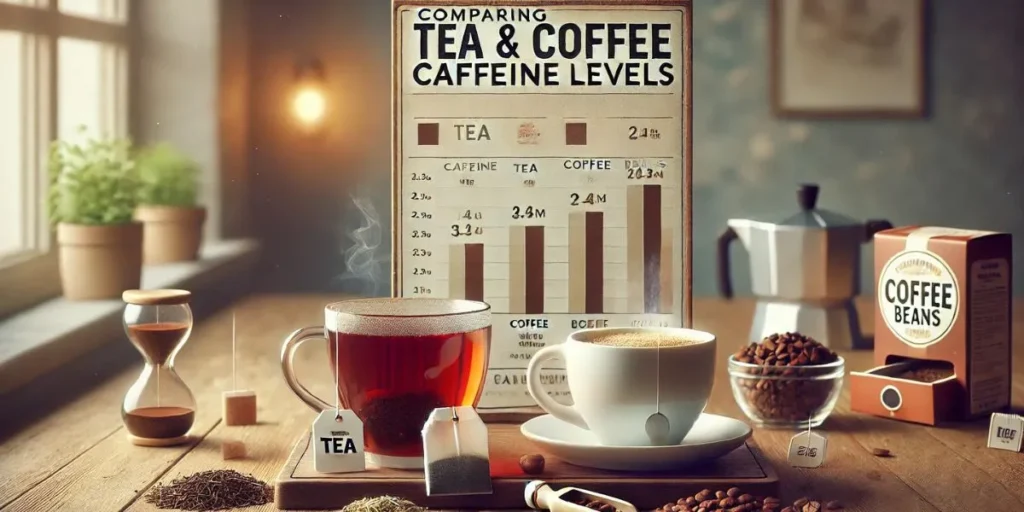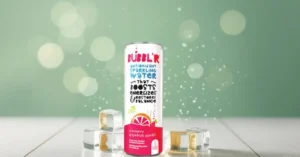Sweet tea, a traditional beverage commonly expended in the Southern United States, has been a symbol of hospitality and refreshment for generations. Made by brewing tea leaves in hot water and adding sugar to sweeten its flavor, this iced drink is both simple and iconic.
While ordinarily crafted with black tea, which contains caffeine, the exact sum of caffeine can change depending on the components like the sort of tea utilized, brewing time, and serving measure.
For a standard 8-ounce serving, sweet tea contains between 10-80 milligrams of caffeine. Home-brewed sweet tea ranges from 10-70 milligrams per 8 ounces, while commercial brands offer 5-40 milligrams per 8 ounces.
The longer you steep the tea, the more caffeine you’ll extract, resulting in a strong, densely brewed tea. For those sensitive to caffeine, decaffeinated versions are prepared by removing most of the caffeine during processing, offering a small caffeine-free alternative for your health needs.
During World War II, disruptions in tea imports led to the widespread use of black tea, which naturally carries more caffeine than green tea. With about 2.56 mg of caffeine per fluid ounce or 41 mg in a 16-fluid-ounce serving, this hallmark of Southern cuisine offers a refreshing, sugary profile, making it a favorite beverage that continues to delight tea lovers everywhere.
Does sweet tea have caffeine?
Sweet tea does contain caffeine, derived from the black tea used in its preparation. A standard 8-ounce glass delivers 20-60 mg of caffeine, roughly one-third the amount found in coffee. Brewing duration and tea concentration directly influence final caffeine levels.
Sweet tea, an iconic American beverage, is believed to have originated in the Southern states. It is enjoyed hot or cold but is most often served chilled and consumed year-round, making it a staple in many households. Traditionally made with black tea leaves or bags, it is a popular drink that contains a fair share of caffeine.
Every fluid ounce has about 2.56 mg of caffeine, which equates to 20 mg per 8 ounces and nearly 41 mg per 16 fluid ounces—a level considered moderate. This balance of sweetness and energy makes sweet tea a refreshing alternative to other drinks.
Fun Facts About Sweet Tea!
- Sweet tea is typically made from black tea.
- Black tea naturally contains caffeine.
- Therefore, sweet tea generally does have caffeine.
- The caffeine content can vary based on brewing time and tea type.
The caffeine content can shift due to variables like the sort of tea utilized, brewing time, and serving size. Black tea usually contains 40-70 milligrams of caffeine when brewed for three minutes, but longer brewing times can increase the amount. Commercially prepared sweet teas may also include added caffeine, so it’s worth checking product labels if you’re monitoring your intake.
For individuals looking for a caffeine-free alternative, herbal teas made from ingredients such as chamomile, peppermint, or other plants and fruits provide an excellent option.
Ingredients in Sweet Tea
The ingredients in sweet tea can vary depending on the recipe or brand, but certain elements are consistently found in both traditional homemade and store-bought varieties. Water serves as the base liquid for brewing, while black tea leaves or tea bags act as the primary ingredient, contributing to the distinctive flavor and caffeine content.
Popular varieties include Ceylon, Assam, or a blend of black teas. Granulated white sugar is the most common sweetener, though the amount often depends on personal preferences or regional traditions. Ice is frequently added to create a refreshing, chilled beverage.
Some variations or additional ingredients enhance the flavor further. These might include lemon juice or slices for a citrusy twist, mint leaves for a fresh, cool flavor, or honey as a natural alternative to sugar.
Certain recipes or brands might use artificial sweeteners to lower the calorie content, or flavoring syrups and extracts to create flavored variations like peach, raspberry, or vanilla. Commercially produced sweet teas may also include preservatives to extend shelf life.
It’s important to note that specific proportions can differ based on the source, from homemade recipes to pre-made products. When purchasing sweet tea, always check the label for a complete list of ingredients, especially if you have dietary restrictions or allergies.
Nutritional Information of Sweet Tea
Sweet tea contains 80 calories, mainly derived from its high sugar content of 20 grams per serving. The beverage has no fat, cholesterol, or dietary fiber, and provides only negligible amounts of sodium, vitamins, and minerals. However, it is important to note that sweet tea, especially when made with black tea, also contains caffeine—approximately 47.5 mg per cup.
| Nutrition Facts | Amount per Serving |
| Monounsaturated Fat | 0 grams |
| Saturated Fat | 0 grams (0% DV) |
| Vitamin D | 0 mcg (0% DV) |
| Total Fat | 0 grams (0% DV) |
| Calcium | 0.2 milligrams (0% DV) |
| Cholesterol | 0 milligrams (0% DV) |
| Iron | 0 milligrams (0% DV) |
| Trans Fat | 0 grams |
| Calories | 80 |
| Dietary Fiber | 0 grams (0% DV) |
| Serving Size | 1 cup (257 grams) |
| Caffeine | 47.5 mg |
| Potassium | 50.2 milligrams (1% DV) |
| Total Carbohydrates | 21 grams (8% DV) |
| Sodium | 0.2 milligrams (0% DV) |
| Protein | 0 grams |
| Sugars | 20 grams |
| Polyunsaturated Fat | 0 grams |
Factors Affecting Caffeine Levels
When determining the caffeine content of your sweet tea, several key factors come into play.
Type of tea leaves
The type of tea leaves is crucial, as the variety acts as the foundational determinant of caffeine levels. For instance, black tea leaves, which are commonly employed in sweet tea, typically contain more caffeine than green or white tea.
Brew time
The brew time is another major influence, as the duration the tea is steeped impacts caffeine extraction—a longer brew time results in more caffeine.
Water temperature
Water temperature also matters. Hotter water, particularly when boiling, extracts caffeine more efficiently compared to warm or cooler water.
Amount of tea leaves
Similarly, the amount of tea leaves used per cup directly influences caffeine concentration, with a higher quantity leading to greater caffeine levels.
Cut off the tea leaves
Additionally, the cut of the tea leaves plays a role; finely cut leaves with larger surface areas enhance caffeine release more than whole leaves.
Sweetness level
Although the sweetness level of your tea does not directly affect caffeine levels, it may alter your perception of its strength.
you can use this information to tailor your sweet tea experience to match your preferred intake.
Brewing Time and Caffeine Levels in Sweet Tea
When you steep tea, the amount of time it stays in contact with hot water directly influences the caffeine extracted from the leaves. Shorter brewing times result in less caffeine while extending the brewing time up to 5 minutes can significantly increase the caffeine level. Typically, steeping tea for 1-3 minutes creates a moderately caffeinated beverage, but brewing longer produces a stronger cup.
The type of tea leaves also affects caffeine levels, with black tea generally containing more caffeine than green tea. Sweet tea, often made from black tea leaves, follows the same extraction principles. For a standard 8 oz serving steeped for 3 minutes, you can expect around 30-50 mg of caffeine, but brewing for 5 minutes raises the content to about 40-70 mg.
These figures are approximate, as the precise caffeine content can vary due to factors like the variety of tea leaves, water temperature, and the amount of tea used. To control your intake, you can adjust your brewing time accordingly, keeping these elements in consideration.
| Steeping Time | Average Caffeine Content |
| 1-3 minutes | Moderate |
| 3-5 minutes | High |
Average Caffeine Content by Sweet Brands
When looking to understand the caffeine content in sweet tea, it’s important to consider the specific brands as amounts vary. Popular options like Gold Peak Sweet Tea and Arizona Sweet Tea fall on the lower end of the spectrum, while Pure Leaf Sweet Tea and Sweet Leaf Sweet Tea contain higher caffeine levels, offering an extra boost of energy for those who prefer a stronger drink.
| Brand | Caffeine Content (per 8 fl oz) |
| Gold Peak Sweet Tea | 15 mg |
| Sweet Leaf Sweet Tea | 30 mg |
| Arizona Sweet Tea | <15 mg |
| Lipton Sweet Tea | 20 mg |
| Pure Leaf Sweet Tea | 30 mg |
Keep in mind that sizes of servings can significantly affect total consumption. For example, a 16 fl oz serving will double the amounts typically listed. To manage your caffeine intake, always check the labels for the most accurate information. Since individual sensitivity to caffeine varies, it’s wise to adjust your consumption based on your personal tolerance.
Caffeine Levels in Homemade Sweet Tea
When you make sweet tea at home, the caffeine content can vary significantly, depending on factors like the type of tea leaves used, the amount per cup, steeping time, and water temperature. Typically, black tea leaves, common in sweet tea recipes, contain 14-70 mg per 8 oz. Popular choices like Assam provide 60-90 mg, while Ceylon offers 50-60 mg per 8 oz.
The amount of tea leaves also impacts caffeine levels. A standard brew uses 1 teaspoon of loose leaf tea or 1 tea bag per cup, while a strong brew requires 2 teaspoons or 2 tea bags. Steeping time is crucial—short steep times (1-2 minutes) result in less caffeine, while longer times (3-5 minutes) maximize extraction for a full-flavor brew.
Water temperature further influences caffeine levels. Boiling water (212°F) extracts the maximum caffeine, while below boiling (~200°F) results in less extraction. Use a thermometer and timer to ensure variables remain consistent for your desired brew strength. Remember, adding sugar or sweeteners does not change the caffeine content, but it enhances sweetness for a better experience.
| Factor | Less Caffeine | More Caffeine |
| Tea Leaf Type | Lower-caffeine varieties | Assam, Ceylon |
| Tea Leaf Amount | 1 tsp/1 bag | 2+ tsp/2+ bags |
| Steep Time | 1-2 minutes | 3-5 minutes |
| Water Temperature | Below boiling | Boiling |
Sweet Tea Variants and Their Caffeine Content
Sweet tea, though traditionally made with black tea and sugar, has evolved over time to include various flavors and adaptations. These changes cater to different tastes and preferences, offering a wide range of popular sweet tea variants for everyone to enjoy.

Lemon Sweet Tea
Lemon Sweet Tea adds lemon juice or slices to the classic recipe, giving it a refreshing citrusy twist.
Peach Sweet Tea
Peach Sweet Tea includes peach syrup or nectar, creating a fruity and slightly tart flavor, especially popular in the Southern United States.
Raspberry Sweet Tea
Raspberry Sweet Tea features raspberry puree for a tangy flavor profile.
Mint Sweet Tea
Mint Sweet Tea uses fresh mint leaves during the brewing process or as a garnish, delivering a cool, refreshing taste.
Arnold Palmer
The Arnold Palmer, named after a famous golfer, mixes equal parts of sweet tea and lemonade, offering a balance of sweet and tart flavors.
Green Tea Sweet Tea
For a lighter option, Green Tea Sweet Tea substitutes black tea with green tea leaves, combining a lighter flavor with potential health benefits.
Decaffeinated Sweet Tea
Decaffeinated Sweet Tea is ideal for those looking to reduce caffeine intake, using a decaffeinated black tea base.
Unsweetened Sweet Tea
Other popular variations include Unsweetened Sweet Tea, where people prefer the natural flavor without any sweeteners,
Half and Half Sweet Tea
Half and Half Sweet Tea, combining equal parts of sweet and unsweetened tea for a balanced sweetness level.
Long Island Sweet Tea
For an adult twist, the Long Island Sweet Tea incorporates spirits like vodka, rum, and tequila, transforming it into an alcoholic cocktail.
Alternatives to Sweet Tea and Their Caffeine Content
If you’re exploring alternatives to sweet tea, considering the caffeine content is important, particularly if you aim to reduce or manage your caffeine intake. Various tea alternatives offer a range of caffeine content, allowing you to choose the best fit for your preferences and lifestyle.

Green Tea
If you’re seeking alternatives to sweet tea, options like green tea offer a slightly lower caffeine content, averaging 28 mg per 8 oz serving. Known for its health benefits, green tea comes in a variety of types with distinct flavors and aromas.
Oolong Tea
Oolong tea, a semi-fermented option, has caffeine similar to green tea but may vary depending on the specific variety and processing methods, offering unique flavors from light floral to full-bodied and rich.
White Tea
For a subtle choice, white tea undergoes little processing and has a delicate floral taste. While often believed to have less caffeine, some studies suggest that its caffeine content can be more, depending on the type and brewing method.
Pu’er Tea
Pu’er tea, originating from China, comes in raw and aged varieties, with caffeine levels tied to its aging process. Its unique flavor profile can resemble green tea in raw Pu’er or take on the deeper, richer tones of black teas in aged Pu’er.
Herbal Teas
For those wanting a caffeine-free option, herbal teas like rooibos, chamomile, and peppermint deliver various flavors and health benefits without caffeine.
Decaffeinated Options for Sweet Tea
If you enjoy the taste of tea but want to avoid caffeine, there are decaffeinated versions of black, green, and oolong teas available. These typically contain only 1-2 mg of caffeine per 8 oz serving. For those looking for options, decaffeinated tea is made by removing most of the caffeine from the leaves, offering a beverage with significantly lower caffeine levels.
Many brands also provide bottled decaf sweet tea, a convenient choice for those who prefer ready-to-drink options. Always check labels for caffeine content, as some may still contain trace amounts.
If you prefer to brew at home, you can buy decaffeinated tea bags. These offer similar flavor profiles to their caffeinated counterparts and can be sweetened to your liking. For a caffeine-free option, herbal teas such as chamomile or peppermint are naturally caffeine-free and make a great choice.
These teas provide a different experience while still satisfying your sweet tea craving. Always read the packaging to ensure the tea is truly decaffeinated and not just lower in caffeine.
| Drink | Caffeine Levels |
| White Tea | 6 to 55 mg per 250 ml serving |
| Oolong Tea | 10 to 60 mg per 8-ounce serving |
| Decaffeinated Teas | 1 to 2 mg per 8-ounce serving |
| Pu’er Tea | 15 to 60 mg per 8-ounce serving |
| Green Tea | 30 to 50 mg per 8-ounce serving |
| Herbal Teas | Caffeine-free |
Comparison with Other Beverages
When considering the caffeine content in sweet tea, it’s helpful to examine how it compares to other popular caffeinated drinks. An 8-ounce (237 ml) serving of sweet tea contains about 15-30 milligrams of caffeine, though this can vary based on preparation methods and the tea variety.
In comparison, sweet tea typically has less caffeine than brewed coffee, espresso, or many energy drinks, but it can contain more caffeine than colas and some brands of green tea. While its caffeine level is comparable to black tea, it can vary widely. For those aiming to reduce caffeine intake, herbal teas, being caffeine-free, provide a great option.
| Beverage | Caffeine Content (per 8 oz) |
| Espresso (per 1 oz) | 63 mg |
| Energy Drinks | 50-160 mg |
| Black Tea | 40-70 mg |
| Herbal Tea | 0 mg |
| Instant Coffee | 30-90 mg |
| Green Tea | 25-45 mg |
| Sweet Tea | 15-30 mg |
| Brewed Coffee | 95-200 mg |
| Cola | 20-40 mg |
Comparing Tea and Coffee Caffeine Levels

Tea, specifically black tea, comes from the Camellia Sinensis plant, while coffee originates from the Coffea plant, which produces fruit. The ripe fruit is harvested for its inner seeds, known as coffee beans. Both beverages contain naturally occurring caffeine, but how each is prepared determines the difference in caffeine levels.
On average, a cup of coffee has about 90 mg of caffeine, whereas sweet tea contains 41 mg. Interestingly, while tea leaves hold 47 mg of caffeine and a coffee bean only contains 6 mg, a tablespoon of ground coffee has between 60 and 110 mg, compared to a teabag’s 47 mg. This shows that while tea holds more caffeine, coffee is the more concentrated beverage, explaining its higher caffeine content in a typical cup.
- Does NOS Energy Drink Have Caffeine? Expert Guide (2025)
- Does Bubbl’r Sparkling Water Have Caffeine? Full Breakdown In 2025
- Does Elderberry Energy Drink Contain Caffeine? Complete 2025 Review
Comparing Sweet Tea and Iced Tea
While some people confuse sweet tea with iced tea, others have a strong preference for one over the other. Sweet tea is believed to have been invented in the Southern United States, whereas iced tea is thought to have originated at the World’s Fair in the Northern states. Despite their differences, both drinks are popular in their respective locations.
The differences lie in how they are made and consumed. Sweet tea involves brewing black tea bags for an extended period, then adding sugar and water before serving it hot or cold (though usually cold). In contrast, iced tea is brewed hot, then chilled and served over ice. Traditionally, sugar isn’t added, but ingredients like lemon, peach, or mango provide natural sweetness.
As far as caffeine, iced tea has a slightly higher content, about 46 mg per fluid ounce, likely due to its steeping and brewing process. Sweet tea, however, uses more water, resulting in a lower concentration. Additionally, iced tea can be made with other varieties like green, chai, or herbal teas, which alter its caffeine capacity, with black tea offering the most caffeine.
Home Brewed Sweet Tea vs Take Out Sweet Tea
A popular question is how much caffeine is in McDonald’s sweet tea, Chick-fil-A sweet tea, and home-brewed sweet tea. Home-brewed sweet tea contains 2.56 mg per fluid ounce, while McDonald’s has 3.12 mg and Chick Fil A offers 3.88 mg per fluid ounce.
Chick Fil A is the clear winner in caffeine content, but how does it compare to an average serving of 16 fluid ounces? Let’s look at the details to understand its ranking.
| Sweet Tea | 41 mg per 16 fl oz |
| Chick Fil A Sweet Tea | 62 mg per 16 fl oz |
| McDonald’s Sweet Tea | 50 mg per 16 fl oz |
| McDonald’s Large Size | 2 fl oz = 100 mg Caffeine |
| Chick Fil A Large Size | 22.5 fl oz = 87 mg Caffeine |
While Chick Fil A’s recipe gives you the most caffeine, both restaurants offer different-sized portions. It’s important to take another look at your possible caffeine intake when choosing your preferred serving size.
Health Implications of Caffeine in Sweet Tea

When you consume sweet tea, you ingest caffeine, a natural stimulant derived from tea leaves. An average 8-ounce serving contains about 14 to 70 milligrams, depending on the strength of the brew and brewing time.
Caffeine affects the central nervous system, creating a temporary increase in alertness and energy levels. However, sensitivity to caffeine varies by individual, leading to different reactions in terms of its health implications.
Potential Health Effects
Drinking sweet tea later in the day may disrupt sleep patterns, potentially causing insomnia. For some, caffeine’s effects on the cardiovascular system—including a short-term increase in heart rate and blood pressure—can be concerning, especially for those with pre-existing conditions.
Excessive consumption can lead to heightened anxiety, jitteriness, and digestive issues, as caffeine stimulates the gastrointestinal system, potentially causing discomfort. Over time, regular caffeine use may result in dependency, with potential withdrawal symptoms such as headaches and irritability if consumption stops suddenly.
Special Considerations
Sweet tea is widely consumed in the southern United States and is growing in popularity in other regions. While its appealing choice lies in its refreshing taste and potential benefits—thanks to antioxidants like polyphenols and flavonoids—it’s crucial to be aware of how factors like type, serving size, and frequency of consumption can influence its effects.
Special attention should be given by pregnant and breastfeeding women, children, and individuals with medical conditions, including anxiety, insomnia, or high blood pressure, to safely enjoy this beloved beverage.
How to Reduce Caffeine in Sweet Tea?
- Use decaffeinated tea leaves: One of the simplest ways to reduce caffeine is by using decaffeinated tea leaves, which are processed to remove most of the caffeine.
- Use fewer tea leaves: Reduce the number of tea leaves when brewing, as fewer leaves will lower the overall caffeine content.
- Brew for a shorter period: Since longer brewing times release more caffeine into the water, brewing for a shorter period will decrease the caffeine in the final drink.
- Use cooler water: Brewing sweet tea with cooler water reduces the amount of caffeine released during the process.
- Mix with herbs: Adding herbs like mint or lemon verbena can dilute the overall caffeine content and provide a refreshing twist.
- Dilute with more water: Adding more water to your brewed tea will further reduce the caffeine concentration.
Recommended Daily Caffeine Intake and Sweet Tea
The caffeine level in sweet tea fluctuates, depending on variables like the variety of tea and the brewing technique. An 8 oz serving of sweet tea contains approximately 30-60 mg, making it a moderately caffeinated beverage.
Individual characteristics such as age, weight, and sensitivity to caffeine influence the recommended daily intake (RDI). For most healthy adults, the FDA recommends consuming no more than 400 mg per day, which is considered safe and generally free of negative effects.
Given its moderate caffeine amount, an 8 oz serving of sweet tea fits well within the RDI for most individuals. This equates to 5-28 cups of sweet tea per day, depending on its strength and preparation. To avoid adverse health effects, moderation is key.
Being aware of implications, performing regular health checks, and understanding your body’s reactions to caffeine will help you manage your consumption responsibly while enjoying sweet tea as part of a balanced diet.
| Consideration | Suggestion for Management |
| Anxiety and Jitteriness | Reduce consumption if symptoms occur. |
| Sleep | Avoid sweet tea close to bedtime. |
| Dependency | Be consistent with your daily caffeine consumption. |
| Digestive Comfort | Limit intake if gastrointestinal discomfort arises. |
| Heart Rate and Blood Pressure | Monitor intake if you have cardiovascular concerns. |
The U.S. Food and Drug Administration (FDA) recommends that adults limit their caffeine consumption to 400 milligrams per day, which is roughly the amount in four to five cups of coffee. This is generally more than the caffeine found in sweet tea, but it’s crucial to account for all sources of caffeine throughout the day. For pregnant women, the FDA advises reducing caffeine intake to 200 milligrams daily.
The European Food Safety Authority (EFSA) offers similar recommendations, suggesting an upper limit of 400 milligrams of caffeine per day for non-pregnant adults. For pregnant or breastfeeding women, the EFSA recommends no more than 200 milligrams daily.
Likewise, Health Canada aligns with these guidelines, advising an upper limit of 400 milligrams per day for the general adult population. For children aged 4-6 years, the limit is 45 milligrams daily.
By following these guidelines, you can effectively manage and monitor your caffeine intake, ensuring it stays within safe levels. Keep in mind that the caffeine content in sweet tea can vary depending on how it’s brewed and the type of tea used, so it’s always a good idea to check the label or consult the manufacturer for specific details if you’re unsure.
Conclusion
Sweet tea falls on the lower to moderate end of the spectrum of caffeinated beverages. While it provides a gentle boost, it’s not as evasive as energy drinks or espresso shots. This loved recipe has been adapted to different parts of the world, with the original version remaining a favorite. For those wanting the flavor without the caffeine, decaffeinated options are a great alternative to maintain the traditional iced tea experience.
Made by brewing black tea leaves with hot water and adding sugar to sweeten, sweet tea contains a stimulant that can increase vitality and sharpness. The amount varies depending on the type, brewing time, and serving size, with an 8 oz cup containing around 14 mg of caffeine—far less than coffee, which ranges from 95-200 mg. If you’re sensitive to caffeine or wish to limit your intake, consider herbal teas, which are naturally caffeine-free and come in a variety of flavors.
FAQs
What kind of tea is sweet tea?
Sweet tea is traditionally made with black tea, a type of tea known for its stronger flavor due to the oxidation process. This method produces naturally occurring caffeine, making it a favored option for individuals looking for a gentle energy boost. Ceylon and Assam varieties are commonly used as the base for sweet tea, thanks to their robust taste and compatibility with sugar.
Is sweet tea healthier than soda?
Generally, both sweet tea and soda are considered unhealthy due to their high sugar content. However, homemade sweet tea allows you to control the sweetness level, making it potentially less detrimental than a sugar-laden soda. For those seeking a healthy option, unsweetened tea offers the most benefits while eliminating added sugars.
Is it possible to make sweet tea without sugar?
Yes, you can still enjoy the refreshing flavor of sweet tea even without added sugar. Explore natural sweeteners like stevia or monk fruit for a healthier option. For a more natural twist, add sliced fruits such as strawberries, peaches, or citrus. These provide a subtle sweetness and a delightful burst of flavor to your tea.
Can I enjoy sweet tea if I’m sensitive to caffeine?
If you are caffeine-sensitive, there are several options to enjoy tea without compromising on flavor. Herbal teas are a great choice as they are naturally caffeine-free and come in a wide range of flavors. For those who prefer the familiar sweet tea taste, decaffeinated black tea is an excellent alternative. It significantly reduces the caffeine content while still retaining the familiar flavor you love.
What is the difference in caffeine content between Coke and sweet tea?
A 12-ounce (355-milliliter) can of Coca-Cola typically contains 34 mg of caffeine, which is comparable to an 8-ounce serving of sweet tea. However, sweet tea may have slightly more caffeine depending on the brew and preparation method.
How long does caffeine from sweet tea last?
Caffeine from sweet tea peaks within 30-60 minutes and remains active for 4-6 hours in most people. Individual metabolism rates affect how quickly your body processes and eliminates the caffeine.
Does iced sweet tea have the same caffeine as hot tea?
Iced sweet tea contains identical caffeine levels to hot tea when brewed using the same method. Temperature during consumption doesn’t alter caffeine content – only the brewing process matters.
How to make low-caffeine sweet tea?
Steep tea bags for only 1-2 minutes to reduce caffeine by half. Alternatively, use decaffeinated tea bags or blend regular tea with herbal varieties.




